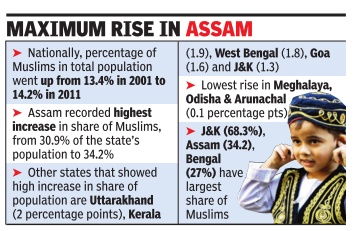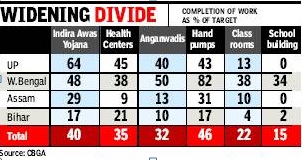Muslims: India (after 1947)
This is a collection of articles archived for the excellence of their content. |
Contents |
Armed forces
The issues explained by Lt Gen Hasnain
Lt Gen Syed Ata Hasnain (R)| The ‘Missing’ Muslim Regiment | 30 November 2017| The Times of India
The writer is former Commander of India’s Kashmir based 15 Corps
Without comprehensive rebuttal, Pakistani propaganda dupes the gullible across the board
Standing between Pakistani propaganda and the Indian nation can be a full time job, especially when it comes to issues about Indian Muslims. It is an enshrined doctrine in Pakistan that India’s fault lines will remain its Achilles heel. The recent controversy – generated by crude video clips inserted into social media networks and reinvigoration of a Pakistani media article of March 2010 – is nothing but a ham handed but potentially mischievous campaign by Pakistan’s Inter Services Public Relations (ISPR).
It’s an issue very few in India know much about: Indian Muslim presence in India’s armed forces and issues concerning alleged disloyalty to the nation, on which across the board gullibility is very high. The essence of the Pakistani disinformation is that a Muslim Regiment existed in the Indian Army till 1965, but was disbanded because in that conflict 20,000 Muslims refused to fight Pakistan.
Thereafter not a single Muslim participated in the 1971 conflict (another lie). Secondly, the percentage of Muslim servicemen as per the article is drastically below the ratio of Muslim population in India. The March 2010 article is more academic, highlighting research by an Indian Muslim scholar in the US who finds no rationale for this or for absence of reservation for Muslims in the armed forces.
Such projections obfuscate reality on the ground. Post-Independence, majority of Muslim officers and soldiers migrated to Pakistan, leaving a minuscule minority as the core or seed element of Indian Muslim servicemen distributed in different regiments and units. In that context new Muslim, Christian or Buddhist regiments made no sense as ethnic and regional identity took priority over faith as entities of representation. However, sub units comprising only Muslims do exist in many units of the Grenadiers, the Rajputana Rifles, Rajput Regiment and some cavalry regiments.
There was no Muslim Regiment ever and certainly not in 1965. But Muslims fighting as part of multi class regiments proved their absolute commitment and worth. Abdul Hamid’s Param Vir Chakra, although a legend, is insufficiently recalled today. Major (later Lt Gen) Mohammad Zaki and Major Abdul Rafey Khan both won the Vir Chakra, the latter posthumously even as he battled the Pakistani division commanded by his uncle, Maj Gen Sahibzada Yaqub Khan.
Such were the legends of Muslim warriors in 1965. The same followed in 1971. In later years Muslim bravehearts of the Indian army proved their mettle in Kargil and in fighting terror groups in J&K. Three army commanders, three corps commanders and a number of two star generals make up the community’s share of achievements in higher ranks.
The public needs to be educated on two aspects of manning in the Indian Army to counter Pakistani ‘psyops’. First, officer ranks. A commissioned officer goes to any regiment or unit irrespective of his ethnicity or faith or that of the regiment. He could be in command of mixed ‘All India All Class’ troops or of a sub unit comprising a single ethnicity.
I, a Muslim, was commissioned in Garhwal Rifles, a pure Hindu regiment with recruitment base only in Garhwal in Uttarakhand. Simply put, the faith of my troops became my faith; similarly their culture, language and food habits have never left me. Indian army officers uniquely remain comfortable with this arrangement, as do their families; it is an ethos not many Indians understand let alone Pakistanis who have never shared a bench or a tiffin box with people of another faith.
Manning below officer ranks is slightly different. Based upon social parameters each state has a recruitable male population (RMP) index. This is based upon the age profile and educational qualifications of the male population among other parameters. There is no reservation based upon profiling by faith, class, caste or ethnicity.
Rightly, in a diverse society the percentages by profile are not revealed as these will always become a subject of controversy which the close brotherhood of the uniform can ill afford. No doubt the Muslim representation at both officer and below officer level may not match its percentage of the population. But efforts to improve that are an ongoing phenomenon as education profiles and awareness improve.
In the officer cadre in particular, since it is open competition, regions with stronger education and awareness profile do have greater population percentage qualifying to be officers. Awareness makes a major difference and that is where the system may have erred in insufficient confidence building among some segments.
In my tours to educate various backward classes on opportunities i have been stumped by Muslim response, when they refuse to believe there is a place for them in the Indian army. Even the case of my own family, where father and son both became generals, is not easily believable by many Muslims.
This perception is exploited by Pakistan, with the additional misperception that it is not easy for them to follow their culture and faith in the forces. Exactly the opposite is true. The essence of India’s plural faith and culture is best symbolised by the armed forces but the projection of that to the recruiting base has been insufficient.
The ease with which Pakistan’s ISPR can exploit non-issues and half truths to advantage for its ‘psyops’ is a reflection of our studied weakness and longtime inability to develop a better communication strategy. More awareness among Indian Muslims and garnering the clergy in social outreach about the opportunities that India has to offer will go far in neutralising Pakistan’s intent.
The writer is former Commander of India’s Kashmir based 15 Corps
Budgetary allocation for Muslims
2007-11
[ From the archives of the Times of India]
Subodh Varma
After the Sachar Committee report in late 2006 unequivocally showed that the Muslim community in India suffers from stark educational and employment deprivation, the UPA government announced a slew of measures targeted at mainly 66 Muslim concentration districts spread over 4 states. These measures included earmarked allocation in various schemes, multi-sectoral development plans (MSDP) scholarships etc.
How have these programmes fared? A detailed analysis done by the Center for Budget and Governance Accountabilit (CBGA), a Delhi-Based advocacy group, throws up a dismal picture. Not only has the government not allocated enough resources for the plans, even the money earmarked has not been spent.
Only 64% of the Rs 8,690 crore allocated to the ministry of minority affairs were actually spent between 2007-2011. Of the Rs 3,632 crore earmarked for the multi-sectoral development programme, just 33% was actually spent. Among the four states with significant Muslim population that is shackled by under-development — West Bengal, Uttar Pradesh, Bihar and Assam — only West Bengal managed to spend about 51% of the funds allocated for the MSDP. UP spent about 33%, Bihar 31% and Assam a meager 20% of the funds.
The results are obvious: key targets for setting up anganwadis, health centres, schools, handpumps etc. have not been met. For instance, in UP, 84,730 low-cost houses were to be built for below poverty line Muslim families, but only 54,045 (64%) were built. Only 5,203 handpumps were installed in Muslim localities against a target of 11,984. In Bihar, just 17% of the low cost houses, 21% of the health centers, 10% of anganwadis were built. In West Bengal and Assam too similar performance is reported, according to the CBGA analysis.
While pre-matric scholarship distribution appears to have exceeded its target, in post-matric scholarship, out of a target of 2.55 lakh, only 37,000 students were actually given. Poor awareness generation among the parents, cumbersome procedure of application and lack of administrative costs being earmarked for implementation are the main reasons for this failure, says the CBGA.
A new programme — the Prime Minister’s 15-Point Programme — has now been initiated to tackle problems. However, it may also flounder unless the grievous lacunae dogging earlier schemes are not corrected, says the CBGA. This includes providing special central funds to states for meeting their obligation of implementing schemes, creating institutional infrastructure at the ground level, providing for administrative costs, targeting mohallas and bastis rather than wards and districts, etc., according to the CBGA.
2014-16, priority-sector loans for Muslims
The Times of India, Mar 14, 2016
Mohammed Wajihuddin
During 2014-15, 2015-16; Muslims got only 2% of 6 PSBs' priority sector loans: RTI
If there were any doubts about low lending by banks to Muslims - one of the reasons for the community's financial exclusion - an RTI disclosure conclusively lays them to rest. Answers received through Right To Information applications to half-a- dozen banks by Mumbai-based activist M A Khalid show that of all priority sector loans, Muslims got a little over 2% in both 2014-15 and till September 30 in 2015-16. The revelation may strengthen the feeling within the community that it is getting further marginalised under the NDA dispensation. Although there are no specific guidelines about granting loans to Muslims, the banks agreed that 15% of the total priority sector loans should go to the minority community. Muslims constituted 14.2% or 17.22 crore (as per the 2011 census) of India's population of 121.09 crore and scholars and community representatives feel their share in bank loans should be much higher. Among the six public sector banks - Punjab & Sind Bank, Allahabad Bank, Corporation Bank, Bank of Maharashtra, Vijaya Bank and Andhra Bank - from which Khalid got information, only Allahabad Bank showed an encouraging trend. It said the share of Muslims in priority sector credit of the bank was 7.07% as on March 31, 2015, which increased to 7.19% on September 30. The bank showing the lowest disbursal of loans to Muslims was Corporation Bank - 1.90% (as on March 31, 2015) and 1.95% (as on September 30, 2015).
"The data clearly shows no extra efforts are being made to increase Muslims' share in loans for minorities under the priority sector. It exposes the hollowness of PM Narendra Modi's 'sabka saath sabka vikas' slogan," said Khalid. TOI sent email queries seeking clarifications to Punjab & Sind Bank, Allahabad Bank, Bank of Maharashtra and Andhra Bank. None replied. However, an official from BoM said over phone that "we are increasing our presence in Muslim pockets by opening more branches".
Dr Abdul Shaban, deputy director, Tata Institute of Social Sciences, said: "In a survey done a couple of years ago it was found that one of the reasons for Muslims' financial exclusion is the negligible presence of banks in Muslim-concentrated areas."
The Sachar Report had observed that many Muslim-concentrated areas were marked by some banks as 'negative' or 'red' zones where they were reluctant to give loans. Since the panel also found that many Muslims are self-employed, an increase in loans to the community will help them become financially strong.
Education
Out-of-school Muslim kids rise in 12 states
[ From the archives of the Times of India]
Himanshi Dhawan TNN
Out-of-school Muslim kids rise in 12 states: Study
Delhi’s boast of being a world-class city starts to ring hollow when it comes to social indices, especially education. Studies show that the number of out-of-school Muslim children has increased from zero to 46,073 in the national capital between 2005 and 2009. Delhi is joined by 12 states, including Gujarat, Uttar Pradesh, Rajasthan, Chhattisgarh, Jharkhand and Uttarakhand, in this hall of shame.
This comes at a time when the average number of out-ofschool Muslim children have come down from 9.97% in 2005 to 7.6% in 2009.
A study done by International Marketing Research Bureau (IMRB) for the HRD ministry to assess the number of out-of-school children found that the estimated number between ages of 6-13 years declined from 134.6 lakh in 2005 to 81.5 lakh in 2009. Of these, the number of out-of-school Muslim children have come down from 22.5 lakh to 18.7 lakh in the same period. However, in Delhi, the number of children outof-school increased from none in 2005 to 46,073 in 2009.
UP saw a sharp increase in the four year period from 7.8 lakh students out-of-school to 10.4 lakh. In Uttarakhand, the number increased from 1,161 to 35,353 while in Rajasthan, Muslim kids who were not in school increased from 26,671 to 38,360.
In Arunachal Pradesh, the number of children out of school jumped from none to 357 while in Chhattisgarh the number increased from zero to 1,045. Gujarat witnessed a hike from 19,678 to 26,285 students while Jharkhand also recorded an increase from 2,798 to 18,167.
Concerned over this trend and a lack of Urdu teachers, the HRD ministry has set up the National Monitoring Committee for Minorities Education and five sub-committees on girl’s education, promotion of Urdu language, mapping of educational requirements of Muslim minorities and implementation of schemes aimed for minorities.
Traditions, state-wise
Nawayath/Nawayati: Karnataka
The Hindu, October 29, 2016
Mohit M. Rao
Partition cleaved the littoral Nawayati community of Bhatkal from their kin in Karachi. Between visa delays, citizenship hardships and the need for approval to venture anywhere out of town, the community faces hardships.
In the small town of Bhatkal, over 14 ‘Pakistani’ wives are currently married to Indian Nawayati men — a tradition that has lasted centuries despite the post-Partition rhetoric.
A passage to India
“Whatever you write, please say that getting the visa is very difficult. As the wife of an Indian, they should let us stay here in peace,” she says for the third time in the brief conversation we have. She stands at some distance in the living room, while we are restrained at the porch. She is one of the few women of Pakistani citizenship in Bhatkal who has consented — albeit reluctantly, and with much persuasion — to talk about her experiences of living in India.
A high wall and metal gates completely cut off their houses from the main road. Their lives are confined to the compound.
The Home Ministry has enquired about visa violations in Bhatkal, and eventually, a head constable of the police station was suspended, while charges under the Foreigners Act, 1946 were filed against some wives who had left the town on an emergency.
The terror tag
The rhetoric against Pakistan, which is reaching a crescendo in political offices and media newsrooms across the country, cuts through the air and lands uncomfortably in Bhatkal where a centuries-old relationship of the scattered Nawayati Muslim community is gradually dissipating.
The town barely stretches six km between the highway and the sea. The skyline is dominated by minarets of mosques (more than 90 estimated to be in the town), while large mansions dot the area — many of them owned by West Asia-based businessmen.
Much of Bhatkal wakes up to the first prayers, when the air is still cool and a slight mist hangs around the distant mountains and on small rivulets that make their way lazily to the sea. Fishermen leave at dawn, following the Chowtani river and out into the open Arabian Sea. Not too long after the last call of prayer ends in the day, Bhatkal goes to sleep.
But in the undercurrents of mosques and coconut trees, shopping streets with ‘Dubai goods’ and restaurants serving the famous Bhatkali fish biryani, there is a palpable nervous energy. Sulaimani tea (spiced black tea) flows here as freely as rapid speeches that attempt to defend the reputation of Bhatkal: a town that heaves under the heavy tag of “terrorism” and “radicalisation”.
The town had shot into infamy in 2010 when the Indian Mujahideen, supposedly founded by three Bhatkal youth — Yasin, Riyaz and Iqbal — were blamed for bomb blasts in Bengaluru and Pune. The notoriety seemed to strengthen as Abdul Kadir Sultan Armar from the town was believed to be recruiting for the Islamic State; Anwar Husain ‘Bhatkal’ is believed to have died fighting alongside the Taliban in Afghanistan; and, early last year, three persons were arrested and “bomb-making” material found at their homes in Bengaluru and Bhatkal.
Nawayati, the language, is evidence of their roots:
It sounds like Persian and Urdu, with smatterings of Marathi and Konkani. Conservative and insular, the community of barely 60,000 is prosperous, having found their fortunes as traders and businessmen in Bhatkal, Karachi, Dubai and Saudi Arabia. Though separated by sea and rigid borders, the pockets of Nawayatis continue to remain in contact. This year, police records show at least 15 persons have visited Bhatkal town from Pakistan — a number remarkably down from the hundreds who would visit before the “terrorism tag” descended on the town.
The Home Ministry’s office in Bengaluru has more than 60 applications for citizenship are pending since 1992, a majority of them from the Nawayati community. Many have left the “stressful” citizenship procedure halfway and migrated to West Asia, an option taken primarily by the younger generation. Some, including the mother of a 10-month-old child, are in Karachi awaiting visas that would allow them to stay with their husbands in Bhatkal. The local qazi, who requests anonymity to stave off any “trouble” — local intelligence men were at his office when The Hindu reporter entered — repeatedly asserts that Nawayatis do not marry ‘Pakistanis’. “It creates an issue if we say that. We have only married those from our community who happen to be in Pakistan due to Partition. We do not seek Pakistanis, we seek Nawayatis.”
Punishment by paperwork
Many of those seeking citizenship narrate the complex journey involved: from dingy rooms of the local police station to the Superintendent of Police in Karwar, to Room No. 224 in Vidhana Soudha in Bengaluru where the Home Ministry has a regional office, and to New Delhi — to the Pakistani embassy to renew their passports (without which Indian visas will not be given) and to attend camps organised by the Union Ministry of Home Affairs. Apart from this, the wives have had to travel to Karachi every two years to renew their identity cards without which Pakistani passports will not be renewed.
Permission for movement is usually given from the SP office in Karwar and is given late. The seven-year-old son of a Pakistani woman fell violently ill and was in ICU in Mangaluru for a week. As permission had not come, she could not attend to her son through his hospitalisation. Similarly, the local police refuse to move files of the citizenship seekers. “They do not even want my money. They are scared of the file, as there is a sense that the might of the Central government will fall on them if the file is signed,” says a citizenship seeker. Another says his application for citizenship had been rejected as the “reports” of different intelligence departments did not tally on minor details.
Visa restrictions as well as the rigmarole of obtaining long-term permission (one to two years at a time) are seeing fewer cross-border marriages now. A local maulvi remembers officiating around 15 weddings in the past decade. All have involved Nawayati women coming from Pakistan as there is a strong belief that Indian authorities will not give visas to Pakistani men. Just three months ago, a wedding of a Bhatkali man to a Karachi bride had to be shifted to Pakistan after the bride’s family was denied visas.
This was not so before the 1990s — when the communal colours of Bhatkal had exploded — and when visa regulations were more relaxed. “In 1965, there was an article describing the region as ‘mini Pakistan’ as many Pakistanis used to visit here.
They would come here as Bhatkal was their home town, and in this mingling of families, marriages would happen,” says M.M. Haneef Shabah, an old-time doctor, who firmly believes that the “terrorist tag” for the Nawayat community was part of a larger conspiracy. “Now, visas are difficult to get, and families do not get it for more than a month. People do not want to visit, and even the weddings have reduced.”
As we scour around Bhatkal, we reach a shop, tiny bottles of homoeopathic medicines lining its cupboards. Syed Anwar (name changed), the owner, narrates the hardships he endured before getting a passport for his wife. Though married for 22 years — and they have had three children — his wife was granted an Indian passport only seven years ago. “We could get the passport done because I had sought political influence. The process is slow and stressful. One has to keep answering the same questions repeatedly to multiple agencies — as if we are all suspects,” he says in a low voice that barely rises from the sounds of the busy bazaar. Did he ever believe that the passport would come? “If I had known getting married to a Pakistani would cause so many visa problems, I would not have married. But it is our fate,” he says plaintively.
The town could soon see another second Pakistani bride getting Indian citizenship if all goes well.
Kerala: Flowers for deities farmed by Muslims
The Times of India, Jun 07 2015
Tp Nijeesh
Malappuram
Flowers for Kerala deities bloom in Muslim farms
It is known to very few devotees that the lotus blooms used in all major temples across the state including Guruvayur Sri Krishna Temple, Sabarimala, Kodungalloor Bhagavathy Temple, Paramekkavu Bhagavathi Temple, Thriprayar Sri Rama Temple and Parshinikkaadavu Muthappan Temple are all farmed by Muslim families.
On an average, the village collects and distributes around 20,000 blooms every day. “Our business has thrived only because of the blessings of the deities and the revenue from temples,“ says a supplier flowers to Guruvayur and Paramekkavu temple in Thrissur from his 85-acre farm.
The flowers are handed over to members of the Warrier community , who handle floral decorations in temples.“The Muslim families of Thirunavaya have maintained a good relationship with all temples,“ says Unni Varrier of Kadambuzha Bhagavathy Temple Devaswom.
But lotus farming is becoming increasingly difficult for farmers. “Water hyacinths pose a major issue. Also, water levels have been receding over the years. Sometimes it is difficult to continue farming, especially with nil government aid,“ he says.
Politics
Muslim votes, Assam, Kerala and West Bengal
The Times of India, March 8, 2016
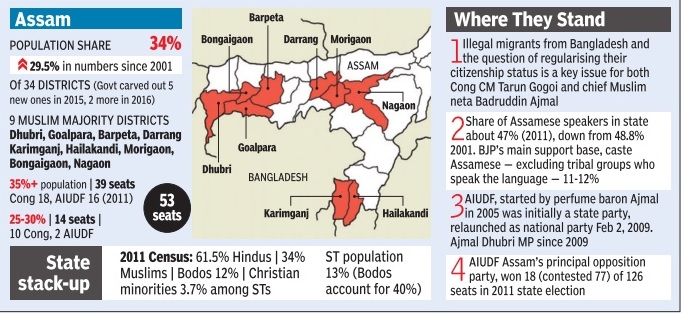
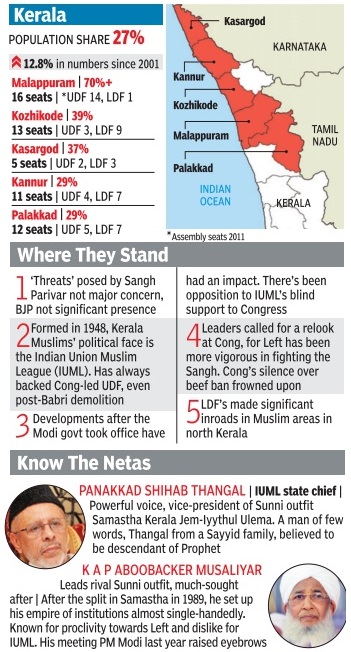
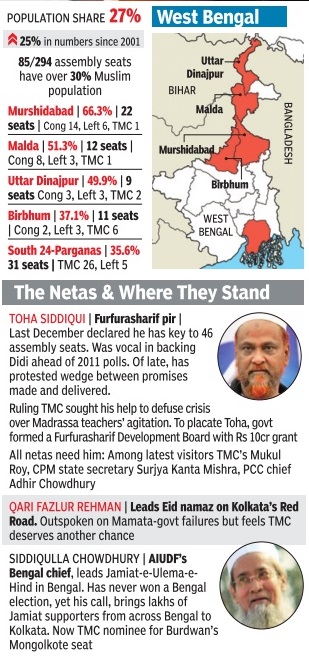
Economic conditions
West Bengal
The Hindu, February 15, 2016
Muslims in West Bengal more deprived, disproportionately poorer: Amartya Sen
Amartya Sen released the report of the survey carried out in 325 villages and 75 urban wards.
Muslims, who form 27.01 per cent of West Bengal’s population, “constitute a very large proportion of the poor” in the State, Professor Amartya Sen said.
He was releasing a voluminous report on the condition of Muslims in West Bengal titled ‘Living Reality of Muslims in West Bengal.’
“The fact that Muslims in West Bengal are disproportionately poorer and more deprived in terms of living conditions is an empirical recognition that gives this report an inescapable immediacy and practical urgency,” Prof. Sen said, releasing the report with long chapters dedicated to education, health, economic conditions and gender of Muslims of Bengal who constitute a majority in 65 of 341 blocks in the State.
The survey — the most extensive one on Bengal’s Muslims — was carried out in 325 villages and 75 urban wards from a sample of 81 community development blocks and 30 municipal bodies. The 368-page report was produced by two Kolkata-based research organisations, Association SNAP and Guidance Guild, in association with Prof. Sen’s trust, Pratichi India.
Low literacy rate
The report points to little improvement in areas such as literacy, health or participation in work. For example, Muslims have a literacy rate seven per cent lower than the State’s average.
“Around five per cent of those who discontinued education admitted lack of motivation as the factor behind dropping out of school as they did not see any future benefits from education,” the synopsis said. However, the report has not named any political party or held any government institution responsible.
In the health sector, the condition of, Muslims is no better and the report observes on the basis of State government data and field-level survey that “when Muslim population percentage increases in the blocks, the hospital facilities dwindle down.”
As a result “almost double the number of hospital beds is available in blocks with less than 15 per cent population share of Muslims in comparison with blocks having 50 per cent or above of (Muslim population).” Such discrimination is underscored in nearly every page of the report.
Population figures
2011: 14.2% of Indians are Muslim
Muslim population grows 24%, but slower than last decade
Bharti Jain The Times of India
Share Up From 13.4% To 14.2% Of Total Popn
The 2011 census data on the population of religious groups shows a 24% rise in the Muslim population between 2001 and 2011, with the community's share of India's total population rising from 13.4% to 14.2% over the 10-year period.
While the growth rate of the Muslim population has slowed from the figure of around 29% recorded between 1991 and 2001, it is still higher than the national av erage of 18% for the decade.
The data accessed by TOI shows that the most rapid rise in the share of Muslims in the total population was witnessed in Assam. Muslims constituted 30.9% of the state's population in 2001, but accounted for a 34.2% share a decade later. The state has had a persisting problem of the illegal influx of Bangladeshi immigrants.
West Bengal, another state where illegal immigration from Bangladesh has been an old phenomenon, has also registered a rise in the share of Muslims in total population from 25.2% in 2001 to 27% in 2011, a growth of 1.8 percentage points over the 10 years, more than double the national average. Uttarakhand reported a sharp rise in the share of Muslim population from 11.9% to 13.9%, a growth of 2 percentage points against the countrywide growth of 0.8 percentage points between 2001 and 2011.
Other states with a significant rise in the share of Muslims in the total population as per the 2011 census were Kerala (from 24.7% to 26.6%), Goa (6.8% to 8.4%), Jammu & Kashmir (67% to 68.3%), Haryana (5.8% to 7%) and Delhi (11.7% to 12.9%).
The census office had compiled this data by March last year, but the UPA government held back the release, perhaps fearing political repercussions of the findings on the eve of Lok Sabha elections. Union home minister Rajnath Singh last week gave his go-ahead when Registrar General of India and Census Commissioner C Chandramouli asked whether the “sensitiive“ figures should be released.
Singh confirmed that the data would be made public soon.
Interestingly , Manipur was the only state to show a fall in Muslim population as a percentage of its total population (a fall of 0.4 percentage points).
The high growth of Muslim population in Assam has been intensely debated and has been a source of political confrontation. In fact, a re port prepared on the issue in 1998 by the then governor of Assam, Lt Gen (Retd) S K Sinha, had warned that illegal immigration was slowly changing the demographic profile in several districts.The Supreme Court has on more than one occasion expressed concern over the change in demography and chided the government for not stopping infiltration from Bangladesh.
2011: Rise in Muslim population
The Times of India, Aug 26 2015
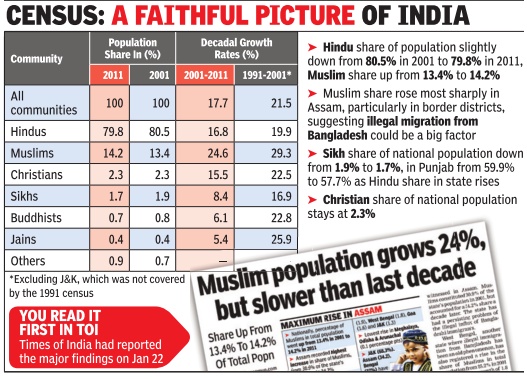
Census: Kerala, U'khand saw rise in Muslim population
The share of Hindus in India's population came down a tad from 80.5% in 2001 to 79.8% in 2011, while the share of Muslims rose from 13.4% to 14.2%, Census data released on Tuesday showed.Among the other large religious communities, Christians remained at 2.3% of the population and the Jains at 0.4%, while Sikhs dropped slightly from 1.9% to 1.7% and Buddhists from 0.8% to 0.7%, the data showed. The official release confirmed what TOI had reported a good seven months earlier, on January 22. The Census has had the data ready for over a year, but had not made it public. Coming as it does in the build-up to the assembly elections in Bihar, the data could stir up even greater heat and passion than it would normally .
In line with the overall decline in the decadal growth rate of the country's population, all religious communities have seen the growth rates of their populations de DIVINE NUMBERS: P 24 clining sharply in the 20012011 period, compared to the rates in the earlier decade.The lowest decline was recorded among Hindus, from 19.9% to 16.8%.
While the national shares of different religious groups have changed only marginally, the changes are somewhat more sizeable in states like Assam, West Bengal, Kerala, Punjab, Uttarakhand and some states in the northeast.
In Assam, for instance, the share of Muslims in the total population has increased from 30.9% in 2001 to 34.2% in 2011. That illegal migration from Bangladesh is playing a part in this is evident from the fact that nine of the state's 27 districts are now Muslim-majority compared to six of 23 earlier. All of these districts are in the areas bordering Bangladesh.
In West Bengal too, the Muslims in 2011 constituted 27% of the population against 25.2% a decade earlier, though in this case the border districts do not show a no ticeable jump in minority population shares compared to 2001. Uttar Dinajpur has joined Malda and Murshidabad in the list of districts where Muslims outnumber Hindus, though at 49.9% they are just short of being an outright majority . Kerala and Uttarakhand have also registered significant increases in the share of the Muslims in their population, while in many other states there is a small increase in the share of Muslims.
In Punjab, on the other hand, the share of Hindus has increased from 36.9% to 38.5%, with the share of Sikhs dropping from 59.9% to 57.7%. The Sikhs have also declined from 16.1% to 13.1% of Chandigarh's population and from 4.0% to 3.4% of Delhi. The Hindu share of population has also risen by one percentage point in Nagaland, and more marginally in Karnataka and Goa and in some of the union territories like.
In Arunachal Pradesh and Manipur, the Christians formed a significantly larger share of the population in 2011 than they did in 2001. In Arunachal, their share rose from 18.7% to 30.3%, while in Manipur it rose from 34% to 41.3%, which is just a little lower than the 41.4% share of population that Hindus have in the state.
Muslims can not be SC
Muslims not entitled to SC status, says HC
The Punjab and Haryana high court on Tuesday ruled Muslims were not entitled to benefits reserved for the Scheduled Castes (SC) while cancelling the 2012 election of Congress MLA Mohammad Sadiq from Punjab's reserved Bhadaur constituency.
Justice N K Sanghi said Sadiq was not qualified to contest from the SC reserved seat as he is a Muslim and had failed to prove he had converted to Sikhism.
Sadiq had claimed before the court he was an SC Muslim before he had converted to Sikhism. He had pleaded he should be considered SC Sikh after his conversion.
The high court order came on the petition of ex-IAS officer and ruling Shiromani Akali Dal's Darbara Singh Guru, who had lost the election to Sadiq by nearly 7,000 votes.
"...the court has found that since he is a Muslim, he cannot get benefits of SCs. The reverse has also been clarified thorough this case," said Guru's lawyer, Satya Pal Jain.
Jain said this is the first judicial pronouncement on who can be considered an SC. "The Constitution (Scheduled Castes) Order, 1950, states that only Hindus, Sikhs and Buddhists can avail benefits as SCs. This is because the caste system is prevalent only in these religions."
Sadiq had told the court his mother, Prasanni Devi, was a Muslim who never followed Islam and that he had "always professed Sikhism and was an SC".
He claimed he belonged to the Doom community, which the Punjab government had notified as SC.
Sadiq, a well-known Punjabi folk singer, claimed he had converted to Sikhism in 2007, but Jain contested this stating he had not follow the prescribed procedure, including notifying the Shiromani Gurdwara Prabandhak Committee.
Guru, a former principal secretary to chief minister Parkash Singh Badal, had accused Sadiq of misleading the Election Commission. He contended Sadiq was still a Muslim.
Guru had filed his petition on March 30, 2012 and the high court had reserved its judgment in January. Barnala-resident Badal Singh had earlier moved the Punjab Scheduled Caste Commission before the assembly polls demanding cancellation of Sadiq's SC certificate that Ludhiana administration had issued in 2006.
Muslims in jail
2016
The Times of India, May 04 2016
Muslims in lock-ups: 1|3rd of India's total in Gujarat
Ashish Chauhan
India has 82,190 Muslims in its jails and police custody . These include 21,550 convicts, 59,550 undertrials in prisons and 658 in lock-ups.
Gujarat has 58.6 lakh Muslims who account for 9.7% of 6 crore Gujaratis.The number of Muslim detainees is disproportionate to the state's share in the country's Muslim population.Gujarat is home to 3.4% of India's 17.2 crore Muslim population. Yet the state accounts for 36.5% of total Muslims detainees. Like Gujarat, the number of Muslim detainees in Tamil Nadu is also disproportionate to that state's share in India's Muslim population, which stands at just 2.5%. Gujarat has 846 convicts -3.9% of Muslims convicted. For undertrials, this figure stands at 1,724, or 2.9%, of Muslim undertrials.
Uttar Pradesh, which has the highest number of Muslims behind bars -including 5,040 convicts and 17,858 undertrials -has just 45 detainees. The state accounts for 22.4% of India's Muslim population. Interestingly , Jammu and Kashmir, which is battling insurgency , accounts for just 35 Muslim detainees. The state accounts for about 5% of India's Muslims. It has 153 Muslim convicts and 1,125 undertrials.
Activists allege that laws like Prevention of Anti-Social Activities Act 1985 (PASA) and the now-repealed Prevention of Terrorism Activities Act (POTA) are used mostly against minorities.
Shamshad Pathan, a citybased civil rights activist and lawyer, alleges that the main reason for detaining Muslims is to instil fear in the minority community .“ After 2000, there was a trend to detain Muslims for interrogation and that, too, on suspicion of terrorism. Police would force these detainees to become informers and threaten them that they would otherwise be framed in cases of terrorism,“ Pathan alleged.
Gujarat minister of state for home Rajnikant Patel denied that people were being victimised on basis of their community. “Offences are registered as per law. No community is targeted while registering any case -be it for PASA or any other offence,“ Patel said.
See also
Muslims in central India: 1916 <>
…and countless other articles about Muslim communities by clicking the Communities link below or by entering a word or phrase in the Search rectangle on the top right of this page.
